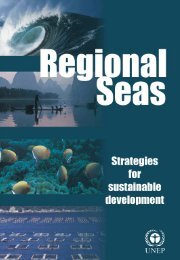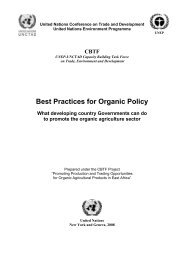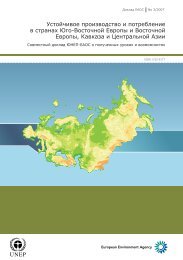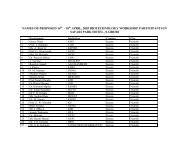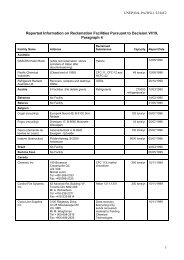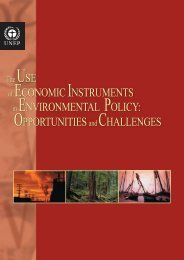Energy Subsidies: Lessons Learned in Assessing their Impact - UNEP
Energy Subsidies: Lessons Learned in Assessing their Impact - UNEP
Energy Subsidies: Lessons Learned in Assessing their Impact - UNEP
You also want an ePaper? Increase the reach of your titles
YUMPU automatically turns print PDFs into web optimized ePapers that Google loves.
<strong>Energy</strong> <strong>Subsidies</strong>: <strong>Lessons</strong> <strong>Learned</strong> <strong>in</strong> Assess<strong>in</strong>g <strong>their</strong> <strong>Impact</strong> and Design<strong>in</strong>g Policy Reforms<br />
corn-based ethanol blended <strong>in</strong>to gasol<strong>in</strong>e. The 2000 report estimates that total subsidies<br />
calculated on an equivalent basis decl<strong>in</strong>ed by 16% <strong>in</strong> real terms compared with 1992.<br />
A 2000 study by Koplow and Mart<strong>in</strong>, commissioned by Greenpeace, estimates the cost of<br />
federal subsidies to the US oil <strong>in</strong>dustry <strong>in</strong> 1995 at between $5.2 and $11.9 billion, exclud<strong>in</strong>g<br />
the costs of defend<strong>in</strong>g Persian Gulf oil supplies. The largest s<strong>in</strong>gle elements are stockpil<strong>in</strong>g<br />
of oil <strong>in</strong> the Strategic Petroleum Reserve to protect aga<strong>in</strong>st supply disruptions and tax breaks<br />
for domestic oil exploration and production.<br />
A 1995 study by Böhr<strong>in</strong>ger at the University of Stuttgart exam<strong>in</strong>es the effects on CO2<br />
emissions of reduc<strong>in</strong>g subsidies to German coal production, us<strong>in</strong>g a general equilibrium<br />
model. His study evaluates <strong>in</strong>come and other economic effects of various possible<br />
modifications of the then current coal support system, subject to different national emission<br />
constra<strong>in</strong>ts (or carbon taxes). The monetary value of coal subsidies is estimated at $6.7<br />
billion <strong>in</strong> 1990, equivalent to DM94,000 to DM145,000 per job per year. The study f<strong>in</strong>ds that<br />
subsidies to coal production become <strong>in</strong>creas<strong>in</strong>gly expensive as carbon constra<strong>in</strong>ts become<br />
tighter. Remov<strong>in</strong>g these subsidies without any additional controls on emissions would<br />
<strong>in</strong>crease national <strong>in</strong>come by almost 1%. The effects on emissions are not reported.<br />
3.3 Conclusions<br />
All OECD countries subsidise to some extent, <strong>in</strong> various ways and for differ<strong>in</strong>g reasons the<br />
production, supply and use of energy. However, few countries systematically attempt to<br />
quantify the value of those subsidies and <strong>their</strong> overall economic and environmental impact.<br />
This is largely because of the complexity of the task, <strong>in</strong>clud<strong>in</strong>g difficulties <strong>in</strong> compil<strong>in</strong>g data<br />
and apply<strong>in</strong>g appropriate methodologies.<br />
Various studies and analyses have nonetheless sought to shed some light on the issue. The<br />
ma<strong>in</strong> f<strong>in</strong>d<strong>in</strong>gs of this work are as follows:<br />
• Significant energy subsidies, mostly to producers, rema<strong>in</strong> <strong>in</strong> place <strong>in</strong> OECD countries.<br />
They are nonetheless much smaller generally than <strong>in</strong> non-OECD countries.<br />
• Most OECD countries have reduced direct subsidies to energy <strong>in</strong> recent years. Coal<br />
subsidies, <strong>in</strong> particular, have been reduced considerably. Regulations support<strong>in</strong>g the<br />
supply or use of particular energy sources, discrim<strong>in</strong>atory taxation and R&D may also<br />
have been reduced overall, though the empirical evidence to support this hypothesis is<br />
<strong>in</strong>complete.<br />
• Most of the subsidies that rema<strong>in</strong> are <strong>in</strong>tended to promote the production and use of<br />
<strong>in</strong>digenous fossil fuel resources (for regional economic, employment and energy<br />
security reasons) and renewable energy sources and energy-efficient technologies (for<br />
environmental and <strong>in</strong>dustrial policy reasons), and to lower the cost of energy for poor<br />
people (for social reasons).<br />
• Many subsidies that encourage the production and consumption of fossil fuels by<br />
lower<strong>in</strong>g the price are offset by taxes, such that net subsidies are small or negative. This<br />
is especially true for oil products. Nonetheless, market distortions are caused by<br />
differential taxation of energy sources.<br />
46



